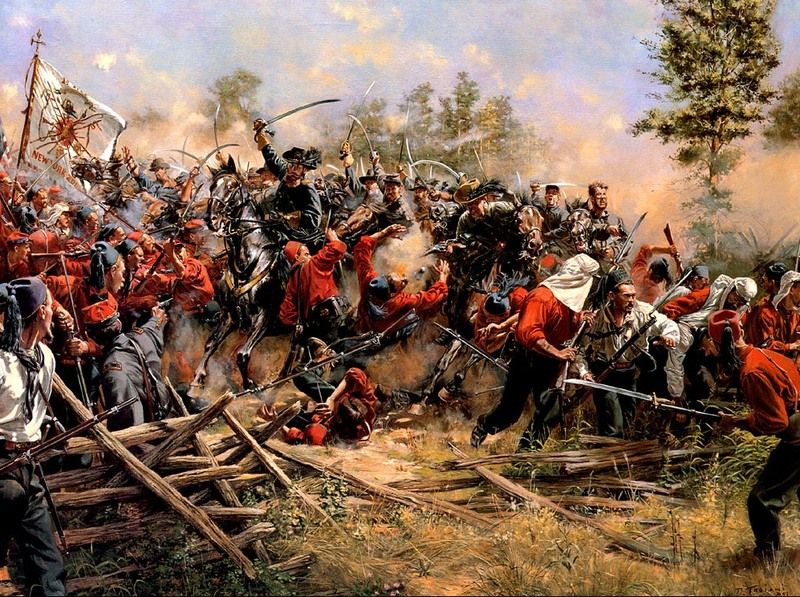- Joined
- Feb 2, 2011
- Messages
- 2,093
NEW RELEASES FOR SEPTEMBER 2020
AMERICAN CIVIL WAR
THE FIRST BATTLE OF BULL RUN, 1861
THE UNION ARMY
THE 11[SUP]th[/SUP] REGIMENT NEW YORK VOLUNTEER INFANTRY
The 11[SUP]th[/SUP] Regiment New York Volunteer Infantry was an infantry regiment of the Union army in the early years of the American Civil War. The regiment was organized in New York City in May 1861 as a zouave regiment, known for its unusual dress and drill style, by Colonel Elmer E. Ellsworth, a personal friend of US president Abraham Lincoln.
The troops were drawn from the ranks of the city’s many volunteer fire companies, and the unit was also known as the Ellsworth Zouaves, First Fire Zouaves, First Regiment New York Zouaves, and US National Guards.
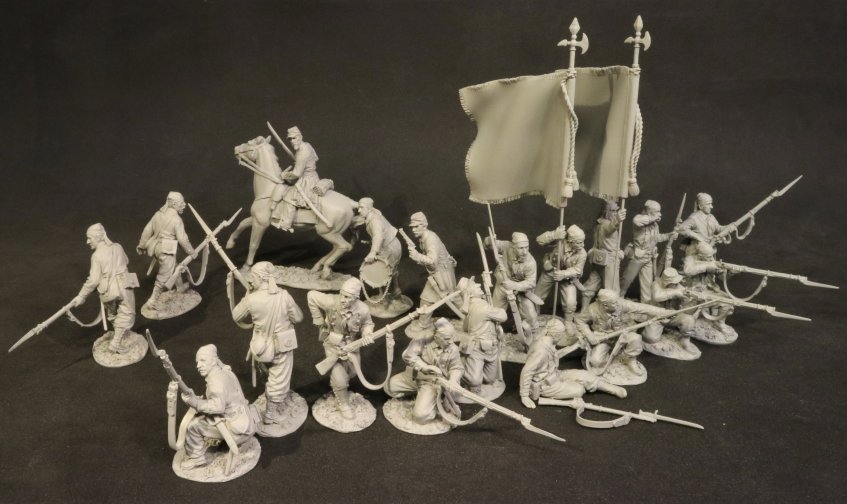
The unit was among the first to occupy the territory of a Confederate state when it captured Alexandria, Virginia on May 24[SUP]th[/SUP] 1861, less than 24 hours after the commonwealth seceded from the Union.
The regiment then went on to suffer extensive casualties during the First Battle of Bull Run, during the fighting on Henry House Hill, and whilst serving as a rearguard for the retreating Union army.
The regiment would later be stationed near Hampton Roads during the Peninsula Campaign, but experienced little fighting. It was sent back to New York city in May 1862, and the regiment was mustered out of service on June 1862.
There were several attempts to reorganize as a light infantry regiment through the summer of 1863, and many new enlistees were involved in suppressing the New York Draft riots. This was to fail and the enlistees were transferred to the 17[SUP]th[/SUP] New York Veteran Volunteer Infantry Regiment.
Ellsworth’s Fire Zouaves marched to Manassas in their zouave jackets and trousers, with red firemen’s shirts and blue fezzes. In the July heat the zouave jackets were abandoned, and most men continued in their red or white firemen’s shirts, and some even added havelock-covered kepis to replace the fezzes. With the officers dressed in Grey, this gave the unit, a motley, multi coloured appearance.
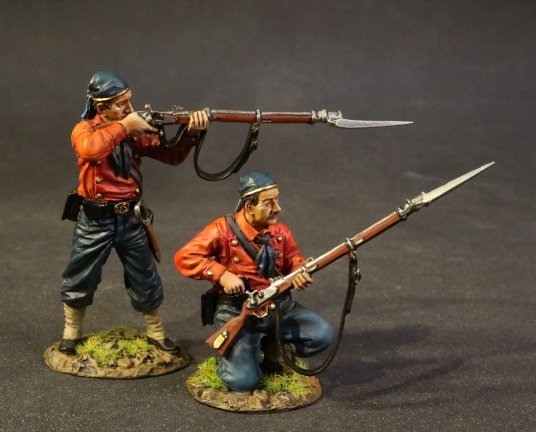
11NY-05
THE AMERICAN CIVIL WAR 1861 - 1865
THE FIRST BATTLE OF BULL RUN, 1861
11[SUP]th[/SUP] REGIMENT NEW YORK VOLUNTEER INFANTRY,
2 INFANTRY FIRING AND LOADING.
(2 pcs)
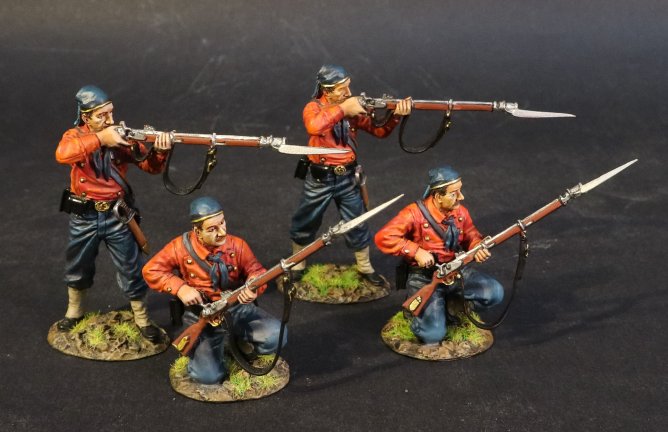
11NY-05N
THE AMERICAN CIVIL WAR 1861 - 1865
THE FIRST BATTLE OF BULL RUN, 1861
11[SUP]th[/SUP] REGIMENT NEW YORK VOLUNTEER INFANTRY,
4 INFANTRY FIRING AND LOADING.
(4 pcs)
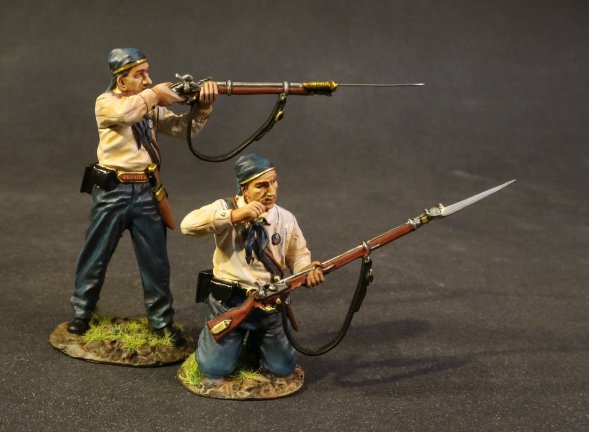
11NY-06
THE AMERICAN CIVIL WAR 1861 - 1865
THE FIRST BATTLE OF BULL RUN, 1861
11[SUP]th[/SUP] REGIMENT NEW YORK VOLUNTEER INFANTRY,
2 INFANTRY FIRING AND LOADING.
(2 pcs)
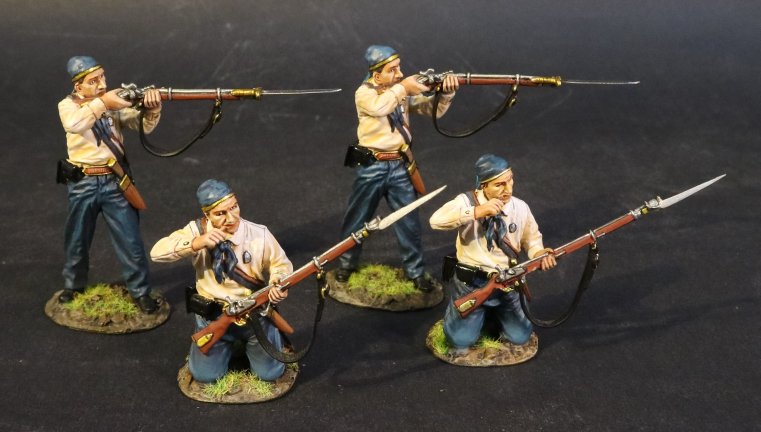
11NY-06N
THE AMERICAN CIVIL WAR 1861 - 1865
THE FIRST BATTLE OF BULL RUN, 1861
11[SUP]th[/SUP] REGIMENT NEW YORK VOLUNTEER INFANTRY,
4 INFANTRY FIRING AND LOADING.
(4 pcs)
THE CONFEDERATE ARMY
THE STONEWALL BRIGADE
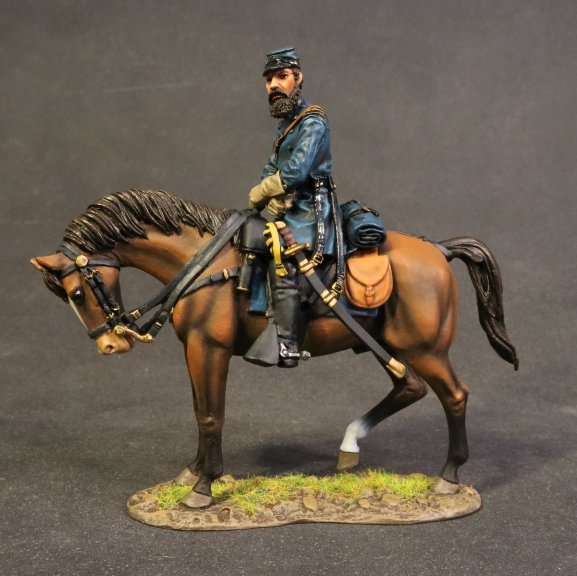
Thomas Jonathan “Stonewall” Jackson (January 21[SUP]st[/SUP], 1824 – May 10[SUP]th[/SUP] 1863) served as a Confederate general during the American Civil War, and became one of the best known Confederate commanders after General Robert E. Lee.
Jackson was to play a prominent role in nearly all military engagements in the Eastern Theatre of the War until his death, and had a key part in winning many significant battles.
JACKSON1861
THE AMERICAN CIVIL WAR 1861 - 1865
THE FIRST BATTLE OF BULL RUN, 1861
BRIGADIER GENERAL THOMAS J. JACKSON.
(2 pcs)
Jackson rose to prominence and earned his most famous nickname at the First Battle of Bull Run (First Manassas) on July 21[SUP]st[/SUP] 1861. As the Confederate lines began to crumble under heavy Union assault, Jackson’s brigade provided crucial reinforcements on Henry House Hill, demonstrating the discipline he had instilled in his men. Although under heavy fire for several continuous hours, Jackson received a wound breaking the middle finger of his left hand, about midway between the hand and the knuckle, the ball passing on the side next to the index finger.
The troops of South Carolina commanded by Gen. Barnard Elliott Bee Jr. had been overwhelmed, and he rode up to Jackson in despair, exclaiming, “They are beating us back!”. Jackson replied “Then, we will give them the bayonet!” As he rode back to his command, Bee exhorted his own troops to re-form by shouting, “There is Jackson standing like a stone wall. Let us determine to die here, and we will conquer. Rally behind the Virginians!”
Jackson’s brigade, which would from then on be known as the “Stonewall Brigade”, stopped the Union assault and suffered more casualties than any other Southern Brigade that say.
After the battle Jackson was promoted to Major General and given command of the Valley District with its headquarters in Winchester.
PLEASE CONTACT YOUR LOCAL DEALER FOR FURTHER INFORMATION
AMERICAN CIVIL WAR
THE FIRST BATTLE OF BULL RUN, 1861
THE UNION ARMY
THE 11[SUP]th[/SUP] REGIMENT NEW YORK VOLUNTEER INFANTRY
The 11[SUP]th[/SUP] Regiment New York Volunteer Infantry was an infantry regiment of the Union army in the early years of the American Civil War. The regiment was organized in New York City in May 1861 as a zouave regiment, known for its unusual dress and drill style, by Colonel Elmer E. Ellsworth, a personal friend of US president Abraham Lincoln.
The troops were drawn from the ranks of the city’s many volunteer fire companies, and the unit was also known as the Ellsworth Zouaves, First Fire Zouaves, First Regiment New York Zouaves, and US National Guards.

The unit was among the first to occupy the territory of a Confederate state when it captured Alexandria, Virginia on May 24[SUP]th[/SUP] 1861, less than 24 hours after the commonwealth seceded from the Union.
The regiment then went on to suffer extensive casualties during the First Battle of Bull Run, during the fighting on Henry House Hill, and whilst serving as a rearguard for the retreating Union army.
The regiment would later be stationed near Hampton Roads during the Peninsula Campaign, but experienced little fighting. It was sent back to New York city in May 1862, and the regiment was mustered out of service on June 1862.
There were several attempts to reorganize as a light infantry regiment through the summer of 1863, and many new enlistees were involved in suppressing the New York Draft riots. This was to fail and the enlistees were transferred to the 17[SUP]th[/SUP] New York Veteran Volunteer Infantry Regiment.
Ellsworth’s Fire Zouaves marched to Manassas in their zouave jackets and trousers, with red firemen’s shirts and blue fezzes. In the July heat the zouave jackets were abandoned, and most men continued in their red or white firemen’s shirts, and some even added havelock-covered kepis to replace the fezzes. With the officers dressed in Grey, this gave the unit, a motley, multi coloured appearance.

11NY-05
THE AMERICAN CIVIL WAR 1861 - 1865
THE FIRST BATTLE OF BULL RUN, 1861
11[SUP]th[/SUP] REGIMENT NEW YORK VOLUNTEER INFANTRY,
2 INFANTRY FIRING AND LOADING.
(2 pcs)

11NY-05N
THE AMERICAN CIVIL WAR 1861 - 1865
THE FIRST BATTLE OF BULL RUN, 1861
11[SUP]th[/SUP] REGIMENT NEW YORK VOLUNTEER INFANTRY,
4 INFANTRY FIRING AND LOADING.
(4 pcs)

11NY-06
THE AMERICAN CIVIL WAR 1861 - 1865
THE FIRST BATTLE OF BULL RUN, 1861
11[SUP]th[/SUP] REGIMENT NEW YORK VOLUNTEER INFANTRY,
2 INFANTRY FIRING AND LOADING.
(2 pcs)

11NY-06N
THE AMERICAN CIVIL WAR 1861 - 1865
THE FIRST BATTLE OF BULL RUN, 1861
11[SUP]th[/SUP] REGIMENT NEW YORK VOLUNTEER INFANTRY,
4 INFANTRY FIRING AND LOADING.
(4 pcs)
THE CONFEDERATE ARMY
THE STONEWALL BRIGADE

Thomas Jonathan “Stonewall” Jackson (January 21[SUP]st[/SUP], 1824 – May 10[SUP]th[/SUP] 1863) served as a Confederate general during the American Civil War, and became one of the best known Confederate commanders after General Robert E. Lee.
Jackson was to play a prominent role in nearly all military engagements in the Eastern Theatre of the War until his death, and had a key part in winning many significant battles.
JACKSON1861
THE AMERICAN CIVIL WAR 1861 - 1865
THE FIRST BATTLE OF BULL RUN, 1861
BRIGADIER GENERAL THOMAS J. JACKSON.
(2 pcs)
Jackson rose to prominence and earned his most famous nickname at the First Battle of Bull Run (First Manassas) on July 21[SUP]st[/SUP] 1861. As the Confederate lines began to crumble under heavy Union assault, Jackson’s brigade provided crucial reinforcements on Henry House Hill, demonstrating the discipline he had instilled in his men. Although under heavy fire for several continuous hours, Jackson received a wound breaking the middle finger of his left hand, about midway between the hand and the knuckle, the ball passing on the side next to the index finger.
The troops of South Carolina commanded by Gen. Barnard Elliott Bee Jr. had been overwhelmed, and he rode up to Jackson in despair, exclaiming, “They are beating us back!”. Jackson replied “Then, we will give them the bayonet!” As he rode back to his command, Bee exhorted his own troops to re-form by shouting, “There is Jackson standing like a stone wall. Let us determine to die here, and we will conquer. Rally behind the Virginians!”
Jackson’s brigade, which would from then on be known as the “Stonewall Brigade”, stopped the Union assault and suffered more casualties than any other Southern Brigade that say.
After the battle Jackson was promoted to Major General and given command of the Valley District with its headquarters in Winchester.
PLEASE CONTACT YOUR LOCAL DEALER FOR FURTHER INFORMATION


